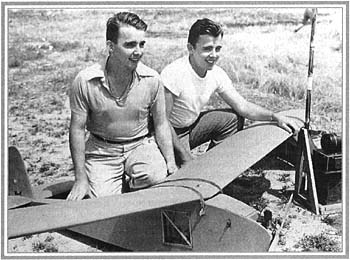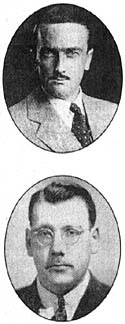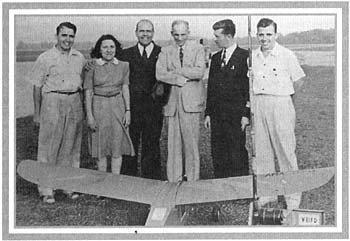THE FIRST DAYS OF
RADIO CONTROL
Walt and Bill Good and their R/C model -
The Guff
(circa 1939). |
R/C PIONEERS
Several men who were active in amateur radio became interested in
the possibility of controlling model planes by radio. Two of these
early pioneers were Ross Hull and Clinton DeSoto. Both were officials
of the American Radio Relay League (ARRL), which is the governing
body of ham radio operators. Hull was a very gifted radio designer
whose achievements include the discovery and eventual explanation
of the tropospheric bending of VHF radio waves. Since his youth
in Australia, Hull also happened to be an avid modeler.
Hull and his associate DeSoto successfully built and flew several
large R/C gliders in the first public demonstration of controlled
flights. Their sailplanes made more than 100 flights. (See the January
August '38 issues of Model |

Ross
Hull
and Clinton DeSoto -
early R/C
pioneers.
|
|

The Good brothers give a flight demonstration for
Henry Ford Sr. (age 80) in 1940. |
|
Airplane News). Tragically, Hull died one year later in 1939 when he
accidentally contacted 6,000 volts while he was working on an early
television receiver. DeSoto died a decade later.
COMPETITIVE
FLIGHT
The 1937 Nationals R/C event attracted six entrants: Walter Good, Elmer
Wasman, Chester Lanzo, Leo Weiss, Patrick Sweeney and B. Shiffman. Lanzo
won with the lightest (6 pounds) and the simplest model plane, although
his flight was a bit erratic and lasted only several minutes. Sweeney
and Wasman both had extremely short (5-second) flights when their aircraft
took off, climbed steeply, stalled and crashed. Sweeney, however, had
the distinction of being the first person to attempt an R/C flight in
a national contest. The other three entrants weren't able to make any
flights at all.
BIRTH
OF THE REED
One of them Weiss; was an 18 year-old aeronautical engineering student
who had constructed a very large, 14-foot-wingspan R/C model. He and
an electrical engineering student, Jon Lopus, had devised a very sophisticated
innovative R/C system consisting of six tuned reeds that reacted to
audio tones. The reed-control system became widely accepted in the 1950s.
During the1937 Nationals, however, Weiss wasn't able to start his plane's
Ferguson twin-cylinder engine. He went on to successfully operate an
avionics manufacturing company.
R/C
EVOLVES
The 1938 Nationals were once again hosted by the "Motor City." Although
the R/C entry list had grown to 26 entrants, only five fliers showed
up on the field. One of the newcomers was DeSoto, who entered a 14-foot-
wingspan, 25-pound, stand-off-scale model of a Piper Cub that was powered
by a Forester twin-cylinder engine. Each of the four separate receivers
on board used a gas-filled Raytheon RK-62 tube in a super regenerative
circuit to activate its own sigma relay. His plane placed second, but
it isn't clear whether or not it actually flew. Oddly enough, these
first contests required only that contestants demonstrate their R/C
systems in a static position on the ground to win a runner-up award.
|
|